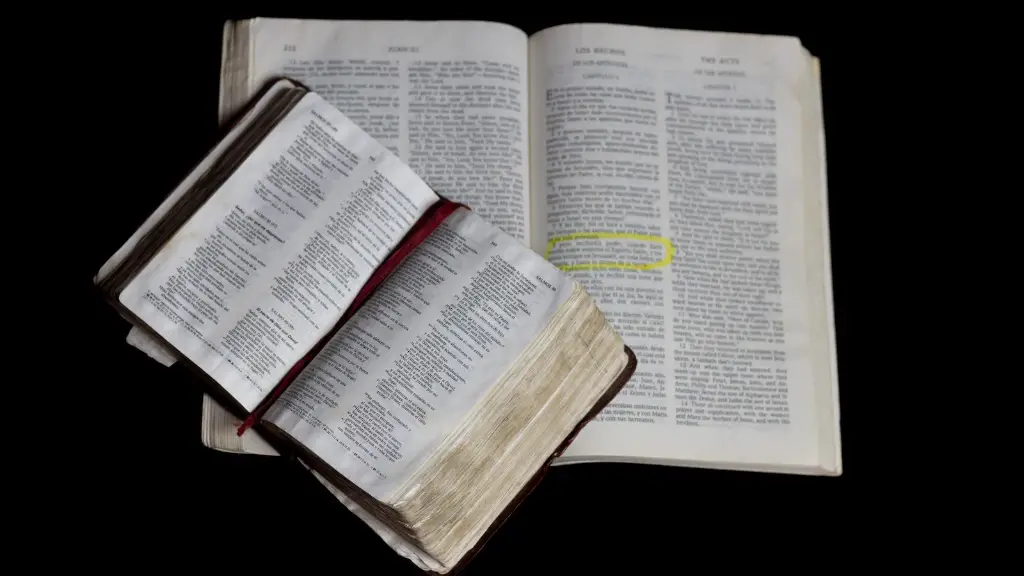What is the Bible Belt?
The Bible Belt is a region in the United States that has a particularly high concentration of conservative Christian churches, as compared to other parts of the country. It is typically associated with a number of states spanning from the southern and central part of the US. The states located in the Bible Belt produce high church membership numbers, and often have higher levels of church attendance.
Among the states oftentimes included in the Bible Belt are Mississippi, Georgia, Alabama, Arkansas, south Texas, south Ohio, North Carolina, South Carolina, and parts of Florida. The Bible Belt is not only marked by high levels of religious attendance and faith-based beliefs, but also by very traditional and conservative social values.
The History Behind the Bible Belt
The term “Bible Belt” first began to appear in the 20th century. It was first used to refer to the southern religious market with a focus on the sale of Christian-related books and other publications.
In more recent times, the Bible Belt has come to refer those states that are known to be populated heavily by evangelical Christians and Protestants. The idea that there is a “Bible Belt” in the United States is a reflection of the patterns of religious settlement and activity in this country over the past few hundred years.
In the 1700s and 1800s, settlers from Scotland and England moved to the southern part of the US in search of economic stability and religious freedom. This wave of settlers introduced a more evangelical form of Protestant Christianity to the area and it has since become a cornerstone of the culture in many of these states.
Some of the Notable Features of the Bible Belt
The Bible Belt is technically a region, but there have been a few notable features associated with it over the years. Some of these features include prohibitions on activities like gambling, drinking alcohol, and dancing. There are also a number of churches in the region that often host events that focus on religious topics.
The churches in these states play an important role, not only in providing a place where people can worship and learn more about their faith, but also in providing an outlet for social gatherings. This includes events and activities such as bible study groups, missionary outreach, and other types of Christian-focused service.
In addition, churches in the Bible Belt often have an influence in the area’s political affairs. Many churches host rallies and events to promote particular candidates and causes, and churches in the region often get involved in larger-scale political activities.
What Makes the Bible Belt Unusual?
What makes the Bible Belt unique is the simple fact that it has more churches per capita than any other region in the United States. This includes major cities like Nashville, Atlanta, and Birmingham.
The Bible Belt is also home to a number of notable Christian schools and universities that are known for producing some of the brightest and most influential Christian thinkers of the past century.
Finally, the Bible Belt is home to some of the most religiously observant states in the US. For example, Mississippi and Alabama are two of the most religious states in the country.
What Challenges Does the Bible Belt Face?
Despite its popularity and influence, the Bible Belt is facing a few major challenges. The first is the fact that many people are moving away from the region. This has caused a decline in church membership numbers, which in turn has led to concerns about the future of Christian-oriented activities and organizations in the region.
In addition, there is the rise of what some might refer to as “secularism”, or a distrust and disinterest in religion in general. This has made it difficult to pass legislation that some churches and religious organizations support, and is a significant challenge for Christian-oriented businesses and organizations in the Bible Belt.
Understanding the Role of the Bible Belt in American Culture
The Bible Belt has played an important role in American culture and history, and it still has a significant impact. It is home to some of the most devout Christians in the country, and is an area that is proud of its religious heritage.
At the same time, however, there are challenges that the region faces. In order to remain a vibrant part of American culture, those living in the Bible Belt must be willing to adapt to the shifting cultural landscape and seek out ways to remain relevant and impactful.
Immigration to the Bible Belt
As the rest of the country has become increasingly diverse, the Bible Belt has also seen a rise in immigration from other countries. This has led to a new wave of diversity in the area, and has changed the way that churches, services, and organizations approach their activities.
Many churches in the Bible Belt have had to adapt their messages and offerings to better fit the needs of their new members. This has caused some tension, as the region is still largely comprised of conservative Christian churches.
At the same time, however, many of these same churches have taken it upon themselves to embrace the newcomers and offer them the same love, care, and spiritual support as they have done for previous generations.
Demographics of the Bible Belt
The demographics of the Bible Belt have also changed in recent years. As mentioned, the region is still largely populated by white, evangelical Christians. However, the population is slowly becoming increasingly diverse, with people from different ethnic backgrounds, religions, and denominations moving to the region.
This has caused the debate over interpretation and application of the Bible in many churches to become more vibrant. This is a positive step, as different backgrounds and perspectives bring important insights that should be acknowledged and discussed openly and respectfully.
The Impact of Social Media on the Bible Belt
Social media has had an interesting impact on the Bible Belt as well. On one hand, it has made it easier to spread the message of Christian values and morals. On the other hand, it has also become a breeding ground for debate and controversy, which can lead to conversations that can be seen as divisive and hostile.
Overall, social media has provided an effective platform for churches and organizations to reach new audiences and spread their messages more quickly. It has also opened up more space for dialogue between different perspectives and can be a powerful force for encouraging understanding and tolerance.
The Bible Belt and the People in It
Despite its challenges, the Bible Belt still serves as a source of hope and community for a large number of Americans. Many churches and organizations are actively seeking to serve their communities in meaningful ways and to promote understanding and compassion.
At the same time, the region is also changing and evolving. As the Bible Belt continues to face new challenges and opportunities, the people who live there will be instrumental in shaping its future.
The Economic Benefits and Drawbacks of the Bible Belt
The Bible Belt is often seen as a region of high poverty and low economic activity. However, the truth is that the region is also home to a number of thriving businesses and industries, including manufacturing, fisheries, and tourism.
While there have certainly been economic drawbacks to the region’s economic policies, the overall trend has been one of growth and improvement. In fact, the region has enjoyed an average of 3.5 percent economic growth over the past decade.
Despite the challenges of inequality, poverty, and low wages, there are still a number of positives associated with the region’s economy. The Bible Belt is home to some of the most innovative and entrepreneurial businesses in the country, and these businesses are helping to create a diverse and growing economy.
Education in the Bible Belt
The educational landscape of the Bible Belt is also evolving. There are still a number of underperforming and low-performing schools in the region, but there are also a number of more successful schools that are making strides to provide a better education for their students.
In addition, the number of college and graduate degree-holding residents of the Bible Belt is on the rise, which can be attributed in part to the investments that have been made in higher education in the region.
The Bible Belt is also home to a number of educational initiatives that are aimed at bringing economic and educational opportunities to the region. These efforts are designed to help ensure that the Bible Belt remains an attractive place for businesses, families, and individuals to live and work.
Conclusion
The Bible Belt is a region in the United States that is known for its religious roots and conservative values. It is home to a number of churches and organizations that are actively trying to spread their message of faith and hope to their communities.
The Bible Belt has faced a number of challenges in recent years, but the region is still home to a number of thriving businesses and educational opportunities. While there are still a number of challenges that the region faces, the future of the Bible Belt remains bright.



